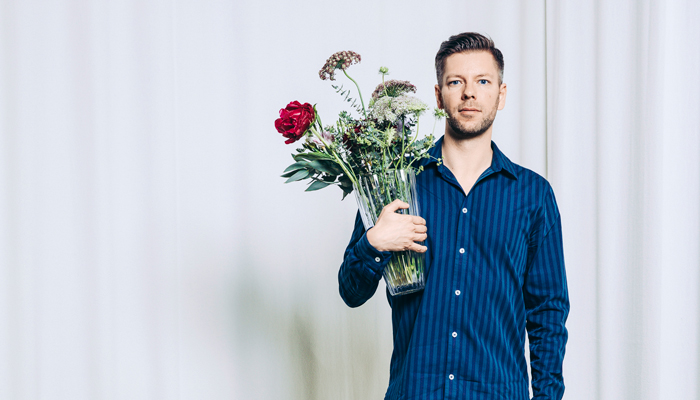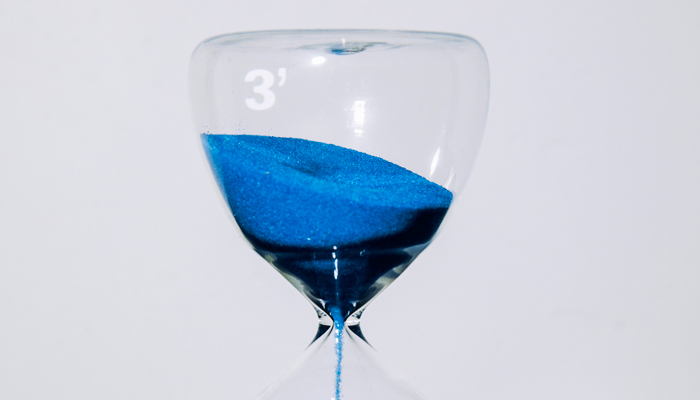Extractor of dreams
Service designer Mikko Koivisto is shaking up how we shop at pharmacies and creating soulful soup meals. Last spring, he received the Ornamo Award for his pioneering work in a field that barely existed just ten years ago.
Everything could have gone differently had it not been for the outdated airplane dishes.
In 2005, Finnair decided to freshen up the visual appearance of its business class meals and asked a group of industrial design students to handle the task. As user-oriented design was all the rage at the time, Mikko Koivisto and his fellows boarded several flights to observe the crew and passengers. In the skies above Europe, they realised that, instead of cups and other tableware, the focus should be on changing how the food was being served on the plane.
“An idea came to me: why isn’t the customer insight process, familiar from product design, also being used for designing intangible things like services?”
Finnair got its new cups, but the idea kept gnawing at Koivisto. Google didn’t even recognise palvelumuotoilu, the Finnish word for service design, but he had more luck searching the term in English, with the search engine taking him to the website of the UK-based Design Council, which vaguely informed him that this was a new and growing area of design. Koivisto wasn’t satisfied with this, however, so he sold his thesis topic to Finnair and embarked on an effort to discover what service design might be about.
From gathering to synthesis
Koivisto grew up in Vaasa and developed a keen interest in design while in secondary school, when his visual arts and woodworking teacher sent the artistic and dexterous pupil on a one-day introductory visit to Design Centre Muova, which is affiliated with Aalto.
“I hadn’t even heard of the whole industry before that. At Muova, I realised what I wanted to be when I grew up.”
That’s how Koivisto wound up studying industrial and strategic design as well as user-oriented design in Helsinki where he also completed the International Design Business Management programme as a minor subject. The IDBM brings together experts in economics, technology and the artistic fields.
“The core of the future Aalto University was already being crystallised in the IDBM. The programme furnished me with commercial and strategic understanding, in addition to which it emphasised the benefits of the usability side that are necessary in service design. I worked on my Master’s studies for several years, which was enormously fruitful: I got to experiment and gather, and all of a sudden it all synthesised into the full idea of service design.”
This idea is, in itself, unambiguous: the development of a service or the creation of something entirely new always starts with people and an understanding of their needs, desires and dreams. These can be extracted with user research methods like surveys, interviews and observation. The newer and more mercurial the issue at hand is, the deeper one must dig. This calls for projective methods such as workshops in which people manually create objects, thus revealing needs and dreams that they may themselves be unaware of.
“When they later explain their work, they also describe their unspoken needs and dreams. This is how many innovative ideas and solutions were created for the services we have developed. This was also the case with the Soup ’n’ Soul soup service concept recently developed for Saarioinen.”

Shush be gone
Koivisto thinks empathy is one of the most important characteristics for a service designer.
“You need to get up close and win the confidence of different kinds of people in this line of work. You’ll also need to be analytic, creative, business savvy and a skilled visualiser in order to shape excavated information fragments into functioning services and viable business activities.”
“Service designers are a bit like film directors. A director will determine the overall vision and narrative of a movie, but an extensive group of experts like actors, set designers and costume designers are needed to make the film a reality. Similarly, a service designer will provide the overall vision of a service and how it is used, while other kinds of designers contribute to various details.”
One of Koivisto’s favourite creations is the service design project implemented for the University of Helsinki student library Kaisa. Students of different degree subjects and classes took part in workshops and the testing of ideas, in addition to which Koivisto and his colleagues observed the library’s users and staff. In total, some 120 service ideas were produced, of which the library chose to realise 12. One was to repeal the tradition of shushing and, in its place, introduce clearly designated areas for complete silence, laptop work, free discussion and eating. Another improvement was the addition of a map button in the Helka search engine to help students find the exact location of a desired work within the multi-storey library building.
Kaisa has been praised in user feedback and it has risen to the top of public facility effectiveness surveys.
Another significant job for Koivisto involved a concept reform for the independent pharmacy chain Yhteistyöapteekit which he realised at his current firm Hellon. The reform transformed an ailment remover into a promoter of wellbeing whose premises provide an opportunity to down health-enhancing shots, browse and shop in a relaxed manner or to observe pharmacists making medicines behind a glass wall. On the prescription medication side, business is conducted standing up, making it easier for pharmacists to leave their desks to show customers products from the over-the-counter section as well. Service sales were modernised, too.
“Pharmacy owners said that people don’t want to pay for services. Well, that’s no wonder if blood pressure measurements are being marketed through a printed A4 price list posted in the corner of the pharmacy!”
The success of the project also had an impact on the bottom line.
“At the Ympyrätalo pharmacy in Hakaniemi, where our idea and thoughts were implemented comprehensively, services now make up a large share of sales and the amount of the average purchase has grown substantially.”

No more potash
When Mikko Koivisto presented his Master’s thesis on service design one decade ago, some of his professors remained sceptical. This spring, he received the Ornamo Award for his achievements as a “pioneer of service design and a designer who has had a key impact on the growth of the sector”.
The selection was made by Pauli Aalto-Setälä, CEO of Aller Media Finland, who lauded service design as the “highest level of design”.
Koivisto thinks that one episode has now come to a conclusion.
“I started doing something entirely new, a thing that was sort of laughed at. But the award made me feel like the effort was now complete, service design has been accepted as a field of expertise alongside other established fields of design.”
Pure service design generates an estimated turnover of €30-40 million in Finland. If the digital agencies and consultancies that also engage in service design are included in the figures, the market is much larger – and it continues to grow. At the same time, services are winning ground in more traditional sectors of industry as well: in the United States, services account for more than 80% of GDP, and even Finland is getting ever closer to the 70% mark.
Koivisto says service design has, to an increasing degree, moved from making improvements to individual services to the strategic planning of service business operations. In future, he believes that human-oriented thinking will expand to, for example, the solving of social problems and legislative work.
And is there something new that he would like to service design next?
“At the start of my career, I dreamed of major assignments, but I’ve come to the conclusion that a project, which at the start may feel minor and even a bit sticky, can be incredibly successful and effective. It would be pointless to rank your work according to some brand,” he says and smiles.
“When I was little, I loved to draw meticulously. Ships were my favourite. I’d first draw a facade and then continue layer by layer, designing the cabins and every other detail. These drawings kept on getting bigger and bigger. I’d love to try my hand at designing cruise liners and customer experiences for them.”
Mikko Koivisto received his Master of Art degree from the industrial design training programme in 2007. He has worked for Satama Interactive, ad agency Taivas and as a freelancer. Nowadays, he is a partner in service design firm Hellon (formerly Diagonal), where he serves as the Customer Experience Director & Lead Service Designer. The firm employs 25 people at its Helsinki headquarters and the London branch office.
Koivisto is one of the most celebrated service design professionals in Finland. Among other accolades, he has received the iF Design Award, the Global Service Design Award as well as several Vuoden Huiput prizes. Koivisto has served as a board member for the World Design Capital 2012 project at the International Design Foundation in 2010–13, a board member for the Finnish Association of Industrial Designers TKO in 2009–12 and as a board member for the Finnish section of the international Service Design Network from 2012 onwards.
This article is originally published in the Aalto University Magazine issue 20, October 2017. (issuu.com)


